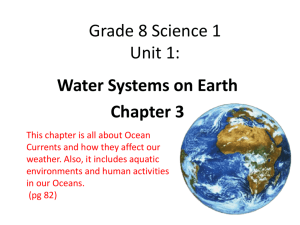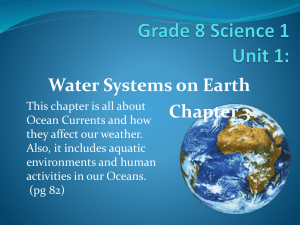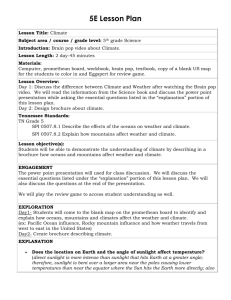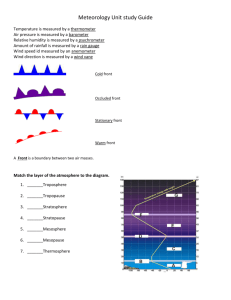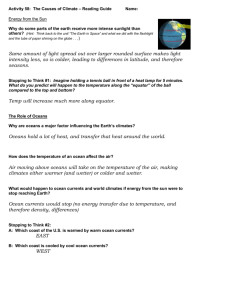File
advertisement
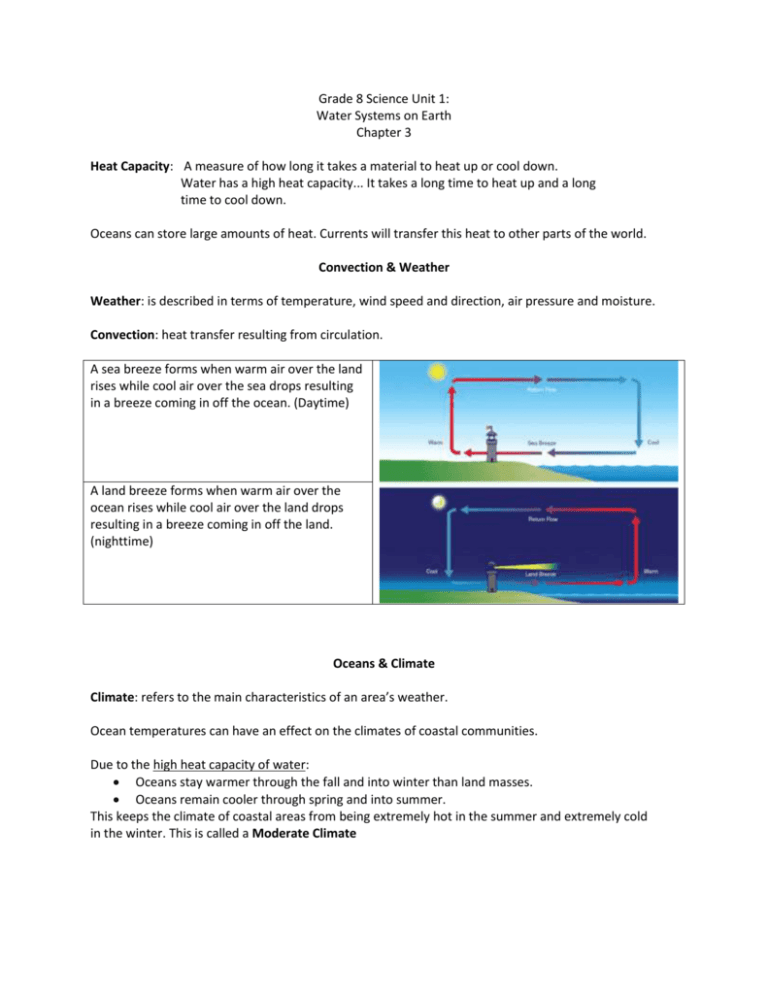
Grade 8 Science Unit 1: Water Systems on Earth Chapter 3 Heat Capacity: A measure of how long it takes a material to heat up or cool down. Water has a high heat capacity... It takes a long time to heat up and a long time to cool down. Oceans can store large amounts of heat. Currents will transfer this heat to other parts of the world. Convection & Weather Weather: is described in terms of temperature, wind speed and direction, air pressure and moisture. Convection: heat transfer resulting from circulation. A sea breeze forms when warm air over the land rises while cool air over the sea drops resulting in a breeze coming in off the ocean. (Daytime) A land breeze forms when warm air over the ocean rises while cool air over the land drops resulting in a breeze coming in off the land. (nighttime) Oceans & Climate Climate: refers to the main characteristics of an area’s weather. Ocean temperatures can have an effect on the climates of coastal communities. Due to the high heat capacity of water: Oceans stay warmer through the fall and into winter than land masses. Oceans remain cooler through spring and into summer. This keeps the climate of coastal areas from being extremely hot in the summer and extremely cold in the winter. This is called a Moderate Climate El Niño... Occurs every 3-7 years. The trade winds do not increase after having been slowed down..The waters are warmer than usual. Is responsible for changing rainfall patterns around the world. Drought& Fire : In places like Australia, Africa Central America Storms &Floods: In places like Peru, Chile, North America These warm waters force the smaller ocean organisms (phytoplankton) to move deeper into cooler water. Fish and other animals that eat these organisms must follow. La Niña... Often follows El Niño The equatorial trade winds increase allowing continuous upwelling of cooler water. Brings heavy rains to Australia, Africa and South America. Marine life flourishes as the upwelling bring nutrients for the phytoplankton. Ocean Current & Climate... Our weather patterns are rapidly changing due to the interaction of the Labrador Current and the Gulf Stream. Warm surface currents transfer tropical heat to the atmosphere and colder currents remove heat from the atmosphere. When the warm, moist air above the Gulf Stream blows over the colder water of the Labrador Current, it cools and condenses, producing fog. Temperature fluctuations occur rapidly in NL due to our location between warm, tropical winds moving north and cold, arctic winds moving south. Local atmospheric temperatures depend on which of these prevail. Abiotic Factors that affect plant and animal distribution: 1. Temperature: Low temperature means more dissolved oxygen. Dissolved Oxygen levels should be = 5 mg/L Phosphates: levels should be < 10 µg/L pH: level of acidity. Range should be 5 –8.5 Turbidity: how cloudy is the water. Pollution: Harmful chemicals and discharges Upwelling: the vertical motion of water in the ocean by which subsurface water of lower temperature and greater density moves toward surface of the ocean bringing with it an abundance of nutrients. Salinity(marine): How salty the water is. Ocean currents (marine): moving heat energy and nutrients around the oceans. 2. 3. 4. 5. 6. 7. 8. Marine Technologies 1.Confederation Bridge 2.Oil rigs 3.Sable Island gas development 4.Fundy tidal power Technologies that have contributed to overfishing include: Fish finding technologies such as radar Factory freezer trawlers Bottom Trawling Offshore Oil Industry. Affects on the marine environments include: 1. Pollution 2. Scouring the ocean floor 3. Marine habitat destruction 4. Release of foreign species in bilge water Aquaculture: The growing and harvesting of marine species in a controlled marine area. Usually built in sheltered areas such as a bay. May have accidental release of organisms and spread of diseases.
